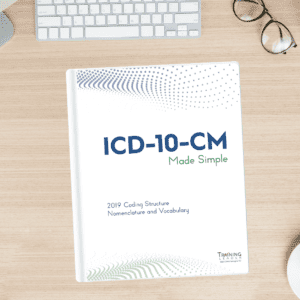
If you’re feeling especially snippy to your staff or can barely summon the energy to get through your work day, you could be struggling from burn out.
This syndrome is increasing so quickly in our modern times that it now has its own diagnosis for burnout: ICD-10-CM code Z73.0.
ICD-11 includes a section for burnout due to chronic unsuccessfully managed workplace stress.
Increased Stress Rates Lead to Creation of Code for Burnout (ICD-10-CM Code Z73.0)
Burnout (ICD-10-CM code Z73.0) is not isolated to work stress. However, that might be the biggest risk factor for burnout in your practice. Stress rates have been escalating for healthcare workers including physicians and office staff.
Minutes spent on patient care keep falling due to increased pressure on profitability and patient quotas. EMR usage means less patient face-to-face time and more time trying to make a medical note fit into a preconceived computer layout schematic.
Mergers and acquisitions drive small practices to fight to compete to avoid take overs or the need to sell. All of that coupled with rising healthcare concerns globally led to the creation of burnout ICD-10-CM code Z73.0.
The World Health Organization now gives the syndrome its own medical classification under the code range for “Factors influencing health status and contact with health services.”
And whenever the U.S. healthcare industry adopts the next classification system ICD-11 categorizes burnout as a syndrome under a section on problems related to employment or unemployment. ICD-11 describes burnout as feelings of energy depletion or exhaustion, increased mental distance or feelings of negativism or cynicism related to one’s job, or reduced professional efficacy.
Prevent Burnout to Increase Productivity, Attendance
As a practice manager spotting burnout (ICD-10-CM code Z73.0) in yourself and your staff can reduce sick days and attrition and improve work productivity and patient satisfaction. Before burnout wreaks havoc on your practice, check out these questions from the Mayo Clinic.
Ok, so you think some folks qualify for burnout ICD-10-CM code Z73.0 or are least approaching the clinical classification. What do you do? While immediately removing the causes of burnout might not be feasible, consider these tips to help perk up your – and your team’s – day.
Get Some Sun to Sidestep Burnout (ICD-10-CM Code Z73.0)
It might be hard to step outside to take a break when juggling a running late schedule or a no-show front desk staff but taking just 5-10 minutes to take a breath of fresh air can do wonders to reset your cortisol levels.
Your patients and staff will notice the calmer you – and you’ll have a greater ability to resist the urge to yell. Encourage your staff too to take a break. Having a new worker who stores the DME in the wrong spot – or putting an office staff in a role for a day that they hate to cover for staff can quickly escalate into a bad office day.
Let them get some perspective by asking them to take a walk around the practice parking lot solo or with a colleague or mentor. All will return fresher and with an improved demeanor.
Postpone Appointments to Make Room for Lunch Breaks
Encourage staff too to squeeze in a mini break. If you see a physician hasn’t had time to eat and is getting run down, move the post lunch appointment back 15 minutes or have the patient wait for the scheduled appointment 10-15 minutes to give the physician time to eat.
Telling patients that their doctor will be right with them as soon as the physician fuels up is not a bad thing.
Bring the patients some water – even some crackers if you store them in your office break room. Chat with the patients and they will feel the warmth from you as well as the renewed energy and focus the provider has when the patient is seen.
Meditate Before the Office Closing Routine
Starting your day off with just 10 minutes of meditation gives your body extra oxygen and reduces blood pressure. There are apps you can try to get started and you can even do so by just sitting up in bed or a chair first thing in the morning to breath and clear your mind. But don’t leave meditation as a tool just for home.
If office hours are done and your providers have a ton of paperwork to still complete or charts to close, encourage them to take a quick break.
Encourage them to squeeze in a rest area in their office where they aren’t overwhelmed by looking at their pile of to-dos or create an all staff quiet small comfy space that will serve the purpose. Feeling angry at staff who left you with the office closing tasks again?
Aside from the performance review action plan to take up, give yourself a 5-minute break to count your blessings, find humor in your day or another mindfulness exercise to put the spring back in your step.
You’ll fly through your closing tasks with more energy and focus. In the long run, those precious quiet moments will save you time and increased blood pressure.
Related ICD-10-CM Online Trainings and Resources Selected For You
-
 2020 ICD-10-CM Codes Update$247.00 – $257.00
2020 ICD-10-CM Codes Update$247.00 – $257.00 -
 ICD-10 Coding: Decipher History vs. Active Condition Codes$277.00 – $917.00
ICD-10 Coding: Decipher History vs. Active Condition Codes$277.00 – $917.00 -
 ICD-10-CM Made Simple: Coding Structure, Nomenclature and Vocabulary$197.00 – $917.00
ICD-10-CM Made Simple: Coding Structure, Nomenclature and Vocabulary$197.00 – $917.00
